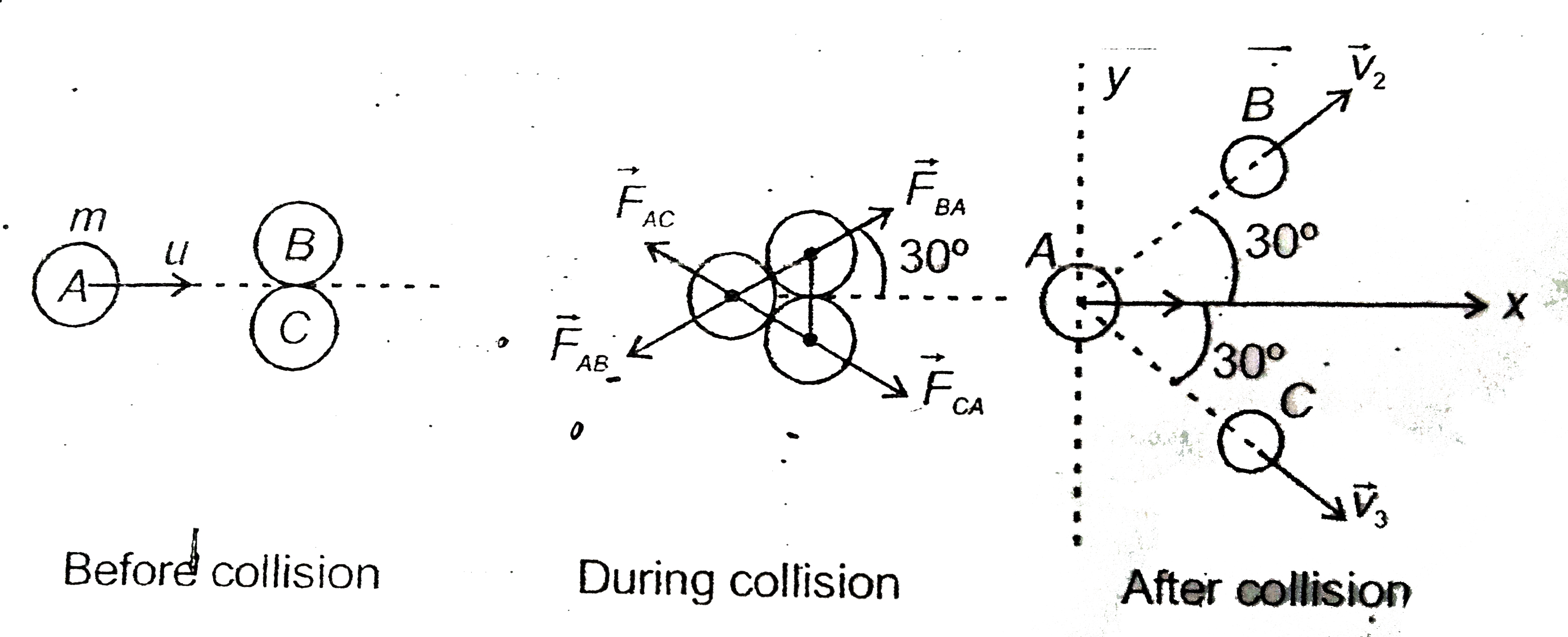B and C are two identicalsphereskeptincontact with eachother on a horizontalfrictionaless floor.Another identicalspherea A moving with velocity u along the common tangent to B and C strikes B and C simultaneously.

Find their velocties after collision if
(a) Collision is elastic
(b) Collision is inelastic with coefficient of restitution e.

By conservation oflinear momentumalongy-axis,
mv2sin30∘−mv3sin30∘=0
⇒v2=v3=vo(say) …(1)
By conservation of linear momentum along x-axis
mu=mv1+mv2cos30∘+mv3cos30∘
v=v1+2v0cos30∘
v=v1+√3v0 ...(2)
Coefficient of restitution,
e=vseparationvapproach
1=v0−v1cos30∘ucos30∘. (for elastic collision)
⇒√3u2=v0−v1√32
u=2v0√3−v1 ...(3)
Adding equation (1) and (2),
2u=√3v0+2v0√3=3v0+2v0√3
u=5v02√3⇒v0=2√3u5 ...(4)
Putting value of v0 in equation (3),
v1=2v0√3−u=2√3¯2√3u5−u
=4u5−u
=−u5 ...(5)
(b) For inelastic collision
Total momentum of the system is conserved. We obrtain the same equations as in part (a) ⇒Equation(1)v1=v3=v0
Equation (2)u=v1+√3v0
Coefficient of restitution.
e=v0−v1cos30∘ucos30∘
⇒eu√32=v0v1√32
⇒u=2v0e√3−v12 ...(6)
Dividing equation (2) by e,
ue=v1e+√3v0e
Equation (6): u=2v0e√3−v1e
Adding, u(1e+1)=1e[5v0√3]
⇒v0=√3u5(1+e) ...(7)
Putting value of v0 in equation (6),
v1=(2v0√3−eu)
=u5(2−3e) ...(8)
Topper's Solved these Questions
- WORK, ENERGY AND POWERBOOK - AAKASH INSTITUTECHAPTER - WORK, ENERGY AND POWEREXERCISE - IILUSTRATION
2 Videos
- WORK, ENERGY AND POWERBOOK - AAKASH INSTITUTECHAPTER - WORK, ENERGY AND POWEREXERCISE - TRY YOURSELF
95 Videos
- WAVESBOOK - AAKASH INSTITUTECHAPTER - WAVESEXERCISE - ASSIGNMENT ( SECTION-D ( Assertion - Reason Type Questions ))
12 Videos
Similar Questions
An object of mass m moving with speed u collides one dimentionally with another identical object at rest. Find their velocities after collision, if coefficient of restitution of collision is e.
View SolutionTwo identical bodies A and B moving with velocities 13 m/s and - 15 m/s respectively collide head-on elastically. What will be their velocities after collision?
View Solution
Knowledge Check
A body of mass a moving with a velocity b strikes a body of mass c and gets embered into it. The velocity of the systems after collision is
Aa+cabBaba+cCab+cDaa+bA sphere A impinges directly on an identical sphere B at rest. If coefficient of restitution is e , the ratio of velocities of A and B after collision is
A1−e1+eB1+e1−eCe1+eD2e1+eIn one dimeensional collision of two particles velocities are interchanged when
(a)Collision is elastic and masses are equal
(b)Collision is inelastic but masses are unequalAOnly 'a' is correctBOnly 'b' is correctCa' and 'b' both are correctDNone of these
A particle of mass m strikes another particle of same at rest. Find the angle between velocities of particles after the collision , if the collision is elastic.
View SolutionA ball of mass m moving with velocity u strikes another identical ball at rest. Find the velocities of the balls after the collision if the coefficient of restitution is e and the collision is head -on. Also , calculate the loss in K.E.
View SolutionA body of mass m moving with a velocity strikes a stationary body having same mass . What will be the ratio of velocity of two bodies after the collision if the coefficient of restitution is e .
View SolutionA and B ----→Elastic collision
B and C ----→ inelastic collision. Find final speed of C
View SolutionTwo indentical balls A and B moving with velocities uA and uB I the same direction collide. Coefficient of restitution is e.
(a) Deduce expression for velocities of the balls after the collision.
(b) If collision is perfectly elastic, what do you observe?
View Solution
